Building Art
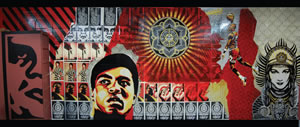
PHOTO COURTESY OF ADAM TRACY
WHEN TIVERTON-R.I. art teacher Adam Tracy and a group of Tiverton Middle School students wanted to start painting a permanent mural in a new fitness center in their middle school in 2011, Tracy invited administrators to stop in and see the youngsters’ work in class. They liked what they saw, and so work began.
The mural, completed after weeks of effort, turned a section of run-of-the-mill cinder block into a cornucopia of rich, deep color and shine. It’s an example of the kinds of initiatives that can transform the walls of K-12 schools.
Building art, whether by students or professional artists, interior and graphic designers, and with varying degrees of complexity, can create teaching and learning opportunities, express school spirit, add verve, and amplify the identities of schools in otherwise nondescript buildings. Examples can be found at schools around the United States, each with its own impetus and result.
For example, in Joplin, Mo., interior art was one part of the process of creating a new, temporary high school in an empty big box retail store. The process took place in a difficult time for the community, which had been hit by a tornado that decimated the old high school building.
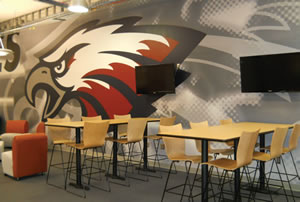
PHOTO COURTESY OF JOPLIN SCHOOLS
Joplin High School Principal Kerry Sachetta tells School Planning & Management that colorful murals and infographics were among many remodeling, interior design and other elements that have enabled students, faculty and staff to feel at home in the temporary space. Combining all these things was a way to go the extra mile after the natural disaster. “The kids had gone through a tragedy,” Sachetta says, “and we wanted to give them something better than just the minimum.”
So school officials talked with the architect and the architect’s interior designers, giving them the parameters of the general look and feel the school was seeking in its interior art and overall design. In this instance, educators stressed the importance of school pride, expressed with art and other elements in Joplin High’s cardinal red, navy and silver colors. In short, educators told the designers, “Eagle it up!” Sachetta quips, referring to the high school’s eagle mascot, which now richly adorns the school.
Another mascot, a tiger, lends itself to another example striking art, this time at Seneca East High School in Attica, Ohio. And according to district Superintendent Laura Kagy, it’s part of an informal process to work with a local artist, Beth Sage of Sagebrush Artistry, to bring art to the school, which was constructed about seven years ago. Kagy explains that various works have been done after teachers and staff come forward with suggestions about what spots in the school could use sprucing up. Perhaps the most striking example so far: a tiger mural in a common area near the school gymnasium.
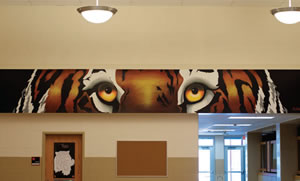
PHOTO COURTESY OF LISA ROMBACH
School identity and spirit can be expressed artistically in countless ways. From notebooks and other supplies and apparel bearing logos and school colors to things on much grander scales. Take for example, the Robert F. Kennedy Community Schools, a campus of six schools serving K-12 in Los Angeles. Opened in 2010, the controversial $578-million building project is on the former site of the Ambassador Hotel, where Kennedy was assassinated in 1968. The new complex proclaims its identity and the site’s history with striking architecture, a memorial and park on its grounds, and a dramatic, colorful mural showing the campaigning senator in its library.
The need for design acumen, the strategic use of color and form also are part and parcel of signage and graphics that, like those forms of art mentioned above, share another dynamic: the potential to help unify the look and identity of an institution and its entire campus. As Ms. Robbie Whyte, president of Whyte-Kerner, an environmental graphics and design firm based in Atlanta, points out, comprehensive signage programs for example, often incorporating a school’s logo, iron out patchworks of signs built up ad hoc over the years.
Whyte’s firm worked with the Westminster Schools on such a program for its large campus setting, utilizing customized APCO Sign products that can be added to in the future as growth dictates. One key takeaway about signage, she adds: “It’s important to provide emotional and intellectual reinforcement of what your institution is about.”
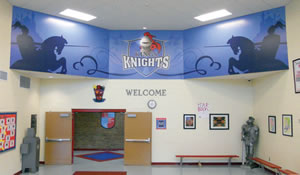
PHOTOS COURTESY OF TEAM FITZ GRAPHICS
Being consistent is also important. School graphics and signage can become diluted over time, as changes in programs and to buildings occur over time, says Shaun Fitzgibbons, co-founder of Team Fitz Graphics, which has created a range of custom graphics, signs, decals, plaques, boulevard banners and other items for schools around the United States, including Kings Local School District, and Sycamore High School, both in Ohio.
He points out, for example, that there may eventually be several shades of a key school color throughout a building, and, overall, a cluttered look, that educators are increasingly looking to reorganize and clean up, so to speak. On another tack, the company has worked with school–ards for photos and plaques recognizing staff and student achievements — a way to graphically express a school spirit that “we’re proud of everybody here,” Fitzgibbons adds.
Back at Tiverton, Tracy and his students’ creative endeavors continue, and students have created silk screens for their extracurricular clubs and sports teams. The youngsters take pride in the projects, which provide first-hand learning in addition to creating credentials for these budding artists. Things have gone well enough for the art team to field requests from the history and science departments for themed murals in their areas of the school, and for the budding artists to go beyond their schools, to creating a logo and signs for a local driving school and hopefully, a public space — Tracy has his eye on a local highway overpass that could be ideal for a civic mural.
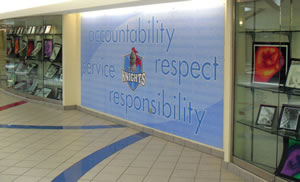
PHOTOS COURTESY OF TEAM FITZ GRAPHICS
Overall, the experience has “just been incredible,” says Tracy. “It’s been a ton of fun. The students love it and everyone has been super supportive.” He adds, “It makes for a good introduction to art. The kids soak it in.” Just as the ubiquitous cinder block walls of school buildings can do with paints in vibrant colors.
Some tips about creating building art to help proclaim and enhance a school’s identity:
“Walk through your school as if you were a first-time visitor,” suggests Shaun Fitzgibbons of Team Fitz Graphics, “Ask yourself what would impress, what would instruct, what would provide the image that you want?”
Remember balance in terms of mottos and mascots. “Don’t overdo it, but make it present,” Fitzgibbons adds.
Take a good look at what your students can do in their arts classes, as Tiverton’s Adam Tracy suggests, and then work with faculty and the students to envision how to apply their talents more permanently around your school.
“Let it be a process that brings the community together,” says Joplin High School’s Kerry Sachetta, who adds, “I’m proud that we did that.”
This article originally appeared in the issue of .